Abu Bakr El-Bediwi* and Samar El-Khaligy
Physics Department, Mansoura University, Mansoura, Egypt
*Corresponding Author:
Abu Bakr El-Bediwi
Physics Department, Faculty of Science
Mansoura University, Mansoura, Egypt
E-mail: baker_elbediwi@yahoo.com
Received Date: March 23, 2019 Accepted Date: April 01, 2019 Published Date: April 10, 2019
Citation: Bediwi ABE, Khaligy SE (2019) Physics Department, Mansoura University, Mansoura, Egypt. J Biomedical Sci Vol.8 No.1:4. doi: 10.4172/2254-609X.1000101
Copyright: © 2019 Bediwi ABE, et al. This is an open-access article distributed under the terms of the Creative Commons Attribution License, which permits unrestricted use, distribution, and reproduction in any medium, provided the original author and source are credited.
Keywords
Saliva; Candida spp.; Vickers hardness; Roughness parameters; Cobalt-chromium based alloy
Introduction
Cobalt and nickel-based alloys are used in the dental industry for making dental prosthesis as an economical alternative to gold and silver based alloys due to their mechanical properties and biocompatibility. Today cobalt-chromium alloys are widely used in prosthetic dentistry for fabrication of removable partial dentures and some fixed prosthetic appliances because they have low weight, good mechanical properties (great hardness, strength, resistance to tarnish and high temperatures) and resistance to corrosion. Cobalt-chromium based alloys are known to have excellent corrosion resistance [1-4]. The first medical use of Co-Cr base alloys was in the cast of dental implants. It is also interesting to develop Co-Cr base alloys suitable for coating with ceramics or so called enameling alloys [5,6]. Cobalt-chromium base alloys have been used for many years as dental and surgical implants due to their excellent resistance to body fluids and biocompatibility [7,8]. Adding different alloying elements to achieve better performances and improve their relatively poor ductility [9]. Variation in casting morphologies by casting method has only a marginal influence on the overall corrosion rate and corrosion resistance property of the Co-Cr alloy [10]. The main parameters of the corrosion process from linear and cyclic polarization curves for five Ni-Cr or Co-Cr alloys in Afnor type artificial saliva are studied by D Mareci et al. [11]. Electrochemical corrosion behavior of Co-Cr and Ni-Cr dental cast alloys depends primarily on the Cr and Mo levels in the alloy [12]. The Ni-Cr alloys more resistant to corrosion in artificial saliva conditioning media, as compared to Co-Cr alloys [13]. The corrosion behavior and passive film characteristics of various dental alloys such as Co-Cr, Ni-Cr, Cu- Ni-Al and commercially pure Ti in artificial saliva medium are studied [14]. The corrosion resistance decreased in the order Cu- Ni-Al>cpTi>Co-Cr (Commercial)>Ni-Cr>Co-Cr (DRDO developed) in artificial saliva solution. Potentiodynamic and electrochemical impedance behavior of Co-Cr and Ni-Cr alloys are studied then concluded that Co-Cr-Mo alloys are more corrosion resistant as compared Ni-Cr-Mo alloys [15]. The corrosion behavior of Cr-Co and Cr-Ni alloys used in restorative dentistry in four different types of solution (distilled water, orange nectar, cola, and artificial saliva) show Cr-Co alloy has lower corrosion current densities than Cr-Ni alloy [16]. The electrochemical behavior of two Ag-Pd alloys used in dental prosthetics construction for crowns and bridges and one Co-Cr alloy in artificial saliva using the polarization curves and electrochemical impedance spectroscopy show the Ag-Pd and Co-Cr have a somewhat good corrosion resistance in artificial saliva [17]. The aim of our research is to study the effect of aging (natural saliva) on the structure and biophysical properties of cobalt-chromium based alloy.
Materials and Methods
In this work, the sample of commercial Magnum H50 alloy, from Travagliato (BS)-Italy, is used after re-melted it and casting in a convenient shape for all tests. Structure of used specimens was performed on the flat surface of all specimens using an Shimadzu X-ray Diffractometer (Dx 30, Japan), (Metallurgy Institute, El-Tebbin, Cairo), of Cu– Kα radiation with λ=1.54056 Å at 45 kV and 35 mA and Ni– filter in the angular range 2θ ranging from 0 to 100° in continuous mode with a scan speed 5 deg/ min. Microhardness test of used specimens were conducted using a digital Vickers microhardness tester, (Model FM-7, Tokyo, Japan), applying a load of 100 gm for 5 seconds via a Vickers diamond pyramid. Ten measurements were recorded for each sample and then the mean value of all measurements was used. Also, surface roughness was measured by surf test S.J 201.P and Voltage Lab PGZ 100 instrument.
Results and Discussions
X-ray analysis
Effect of aging in normally pooled saliva on the structure was studied by x-ray diffractometer. Figure 1 shows X-ray diffraction patterns of Co64Cr29 Mo6.5A0.5 (A=C, Si, Fe, Mn) alloy before and after aging in normal saliva for 1, 4 and 6 weeks which have sharp lines of, fcc Co phase. The details of formed phases (intensity, position, Miller indices, and crystal size) before and after aging in normal saliva are shown in Table 1a-1d. From these results, it obvious that Co64Cr29 Mo6.5A0.5 (A=C, Si, Fe, Mn) alloy consists of cubic Co phase. In reality, the matrix of alloy presents as a metastable phase, contained the fcc Co phase and a solid solution hexagonal σ (Co-Cr). Also, the shape of formed phases (intensity, broadness, and position) and crystal size (τ) are changed after aging in normal saliva.
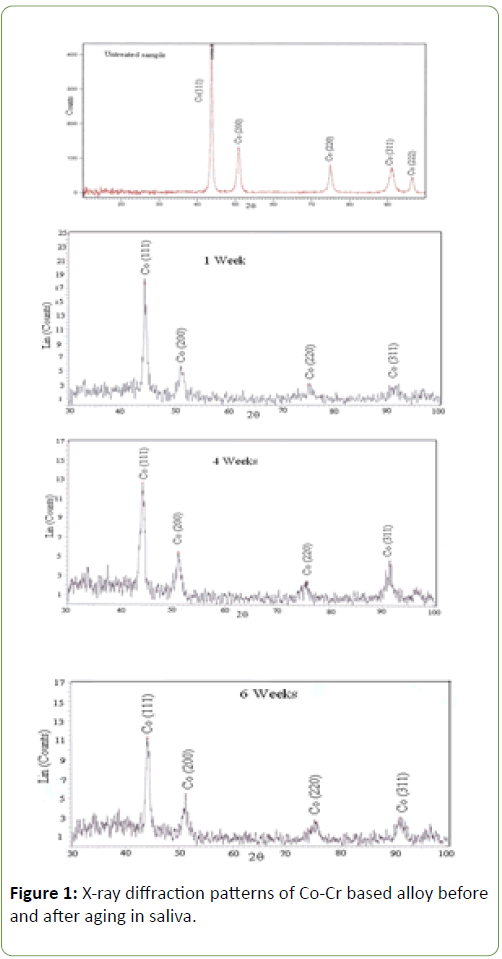
Figure 1: X-ray diffraction patterns of Co-Cr based alloy before and after aging in saliva.
| a) Normal sample |
| 2θ° |
d Å |
Int.% |
phase |
hkl |
τ Å |
| 43.72 |
2.07 |
100 |
Co |
111 |
434.76 |
| 50.96 |
1.79 |
28.97 |
Co |
200 |
139.67 |
| 74.9 |
1.27 |
18.28 |
Co |
220 |
254.13 |
| 91.12 |
1.08 |
25.33 |
Co |
311 |
288.16 |
| 96.56 |
1.03 |
9.82 |
Co |
222 |
138.11 |
| b) Aging for one week |
| 2θ° |
d Å |
Int.% |
phase |
hkl |
τ Å |
| 44.294 |
2.04332 |
17.4 |
Co |
111 |
14.5 |
| 51.13 |
1.78501 |
5.04 |
Co |
200 |
13.1 |
| 75.192 |
1.2626 |
2.77 |
Co |
220 |
8.3 |
| 91.304 |
1.07718 |
3.07 |
Co |
311 |
3 |
| c) Aging for four weeks |
| 2θ° |
d Å |
Int.% |
phase |
hkl |
τ Å |
| 44.097 |
2.05198 |
12.6 |
Co |
111 |
14.7 |
| 50.987 |
1.78969 |
5.27 |
Co |
200 |
13.4 |
| 75.335 |
1.26056 |
2.26 |
Co |
220 |
9.8 |
| 91.304 |
1.07718 |
4.05 |
Co |
311 |
6 |
| d) Aging for six weeks |
| 2θ° |
d Å |
Int.% |
phase |
hkl |
τ Å |
| 44.108 |
2.0515 |
11 |
Co |
111 |
13.1 |
| 51.202 |
1.78268 |
5.18 |
Co |
200 |
15 |
| 75.407 |
1.25954 |
2.3 |
Co |
220 |
13.2 |
| 91.089 |
1.07916 |
2.88 |
Co |
311 |
6.2 |
Table 1: X-ray analysis of Co- Cr based alloy before and after aging in saliva.
Vickers hardness
The microhardness value was conducted using a digital Vickers microhardness tester, applying a load of 100 g for 5s, for Co64Cr29 Mo6.5A0.5 (A=C, Si, Fe, Mn) alloy. Vickers hardness and maximum shear stress (τm) values of Co64Cr29 Mo6.5A0.5 (A=C, Si, Fe, Mn) alloy before and after aging in normal saliva for 1, 4 and 6 weeks are varied as shown in Figure 2. That is because of chemical/or biological interaction of saliva with the surface alloy produced sub hard layers and with decreased grain size.
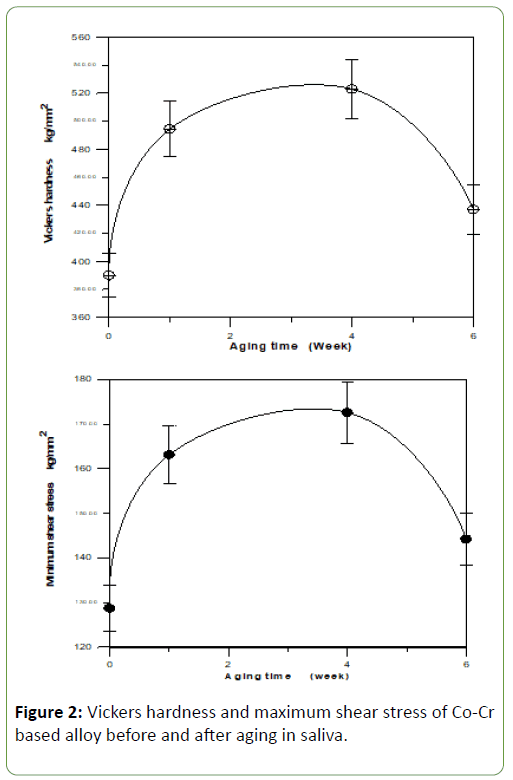
Figure 2: Vickers hardness and maximum shear stress of Co-Cr based alloy before and after aging in saliva.
Roughness
The roughness profiles of Co64Cr29 Mo6.5A0.5 (A=C, Si, Fe, Mn) alloy before and after aging in saliva for 1, 4 and 6 weeks are shown in Figure 3. Also, the average surface roughness parameter Ra along the total sliding distance and other roughness parameters are listed in Table 2. The surface roughness parameter Ra and other roughness parameters of Co64Cr29 Mo6.5A0.5 (A=C, Si, Fe, Mn) alloy decreased after aging in normal saliva. That is because the chemical interaction of saliva with the alloy surface and/or formed and growth of fungal due to surface smoothing.
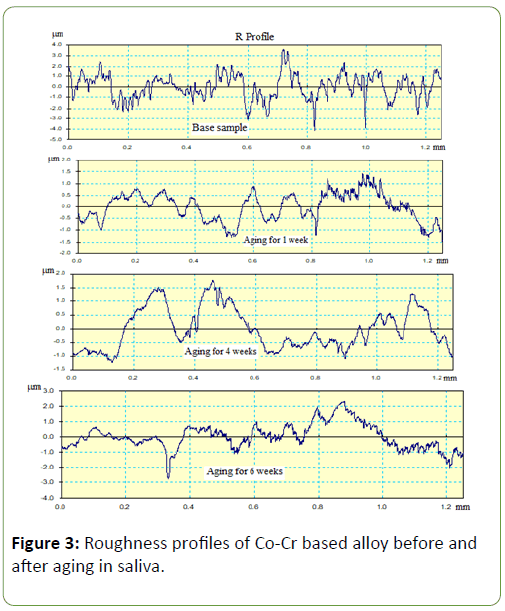
Figure 3: Roughness profiles of Co-Cr based alloy before and after aging in saliva.
| Roughness parameters (mm) |
Normal |
1 week |
4 week |
6 week |
| Ra |
0.95 |
0.95 |
0.64 |
0.6 |
| Rz |
5.22 |
5.22 |
2.11 |
2.32 |
| Rq |
1.14 |
1.14 |
0.72 |
0.76 |
| Rt |
7.71 |
7.71 |
3.01 |
5.08 |
| Rp |
2.48 |
2.48 |
1.15 |
0.9 |
Table 2: Roughness parameters of Co-Cr based alloy before and after aging in saliva.
Microbiology examination
The Co64Cr29 Mo6.5A0.5 (A=C, Si, Fe, Mn) alloy aged for 1, 4 and 6 weeks at 37°C in normally pooled saliva (a pool of ten equal samples from apparently healthy individuals). The microbiological investigation revealed the Candida spp., Figure 4, is stuck on the alloy surface. Optical micrographs, Figure 5, show the growth of Candida spp. on the alloy surface increased with increasing aging time and it is reached to the maximum value at 4 weeks.
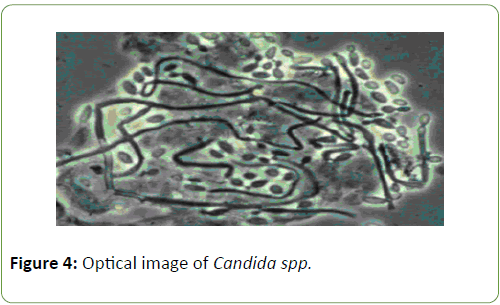
Figure 4: Optical image of Candida spp.
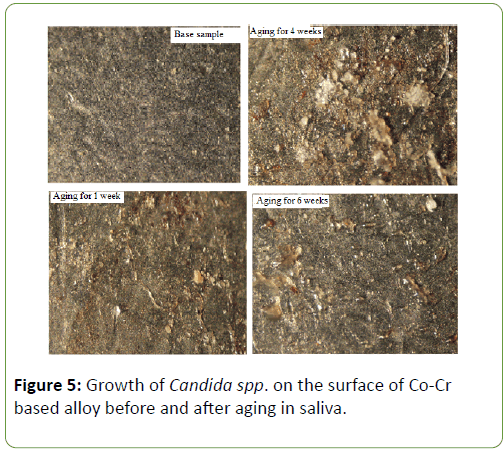
Figure 5: Growth of Candida spp. on the surface of Co-Cr based alloy before and after aging in saliva.
Conclusion
• Structure (Co phase, matrix alloy and crystal size) of Co64Cr29 Mo6.5A0.5 (A=C, Si, Fe, Mn) alloy changed after aging in saliva
• Vickers hardness value of Co64Cr29 Mo6.5A0.5 (A=C, Si, Fe, Mn) alloy increased after aging in saliva
• Surface parameters of Co64Cr29 Mo6.5A0.5 (A=C, Si, Fe, Mn) alloy decreased after aging in saliva
• The growth of Candida spp. on Co64Cr29 Mo6.5A0.5 (A=C, Si, Fe, Mn) alloy surface increased with increasing aging time.
24262
References
- Lucas LC, Dale P, Buchanan R, Goll Y, Griffin D, et al. (1991) In vitro vs. In vivo corrosion analyses of two alloys. J Invest Surg 4: 13-21.
- Gerstorfer JG, Sauer KH, Passler K (1991) Ion release from Ni-Cr-Mo and Co-Cr-Mo casting alloys. Int J Prosthodont 4: 152.
- Grimido NJ (2001) Biocompatibility of nickel and cobalt dental alloys. Gen Dent 49: 498-503.
- Dong H, Nagamatsu Y, Chen KK, Tajima K, Kakigawa H, et al. (2003) Corrosion behavior of dental alloys in various types of electrolyzed water. Dent Mater J 22: 482-493.
- Kelly JR, Nishimura I, Campbell SD (1996) Ceramics in dentistry: historical roots and current perspectives. J Prosthet Dent 75: 18-32.
- Esteban SL, Saiz E, Fujino S, Oku T, Suganuma K, et al. (2003) Bioactive glass coatings for orthopedic metallic implants. J Eur Ceram Soc 23: 2921-2930.
- https://www.zvab.com/9783136220023/Zahn%C3%A4rztliche-Werkstoffkunde-Technologie-Karlheinz-Ludwig-3136220021/plp
- https://www.bookdepository.com/Materials-Science-Technology-Medical-Dental-Materials-v-14-D-F-Williams/9783527268276
- Longquan S, Northwood DO, Zhengwang C (1993) Alloy design and microstructure of a biomedical Co-Cr alloy. J Mater Sc 28: 1312-1316.
- Viswanathan SS, Choe HC (2009) Electrochemical behavior of Co-Cr and Ni-Cr dental cast alloys. Trans Nonferrous Met Soc China 19: 785-790.
- Mareci D, Nemtoi G, Aelenei N, Bocanu C (2005) The electrochemical behavior of various non-precious Ni and Co based alloys in artificial saliva. Eur Cell Mater 10: 1-7.
- Roachm D, Wolan JT, Parsell DE, Bumgardner JD (2000) Use of X-ray photoelectron spectroscopy and cyclic polarization to evaluate the corrosion behavior of six nickel-chromium alloys before and after porcelain-fused-to-metal firing. J Prosthetic Dentistry 84L: 623-634.
- Nejatidanesh F, Savabi O, Yazdanparast A (2005) An Investigation on metallic ion release from four dental casting alloys. J Dentistry 2: 168.
- Sharma M, Kumar AVR, Singh N, Adya N, Saluja B (2008) Electrochemical corrosion behavior of dental/implant alloys in artificial saliva. J Mater Eng Performance 17: 695-701.
- Ameer MA, Khamis E, Motlaq MA (2004) Electrochemical behaviour of recasting Ni-Cr and Co-Cr non-precious dental alloys. Corr Sci 46: 2825-2836.
- Bayindir F, Korkut O, Güngör H (2010) Potentiodynamic polarisation technique for corrosion testing of Cr-Co and Cr-Ni alloys in artificial saliva and soft drinks. Material Research Innovation 14: 280.
- Mareci D, Sutiman D, Cailean A, Bolat G (2010) Comparative corrosion study of Ag-Pd and Co-Cr alloys used in dental applications. J Bulletin of Mater Sci 33: 65.










